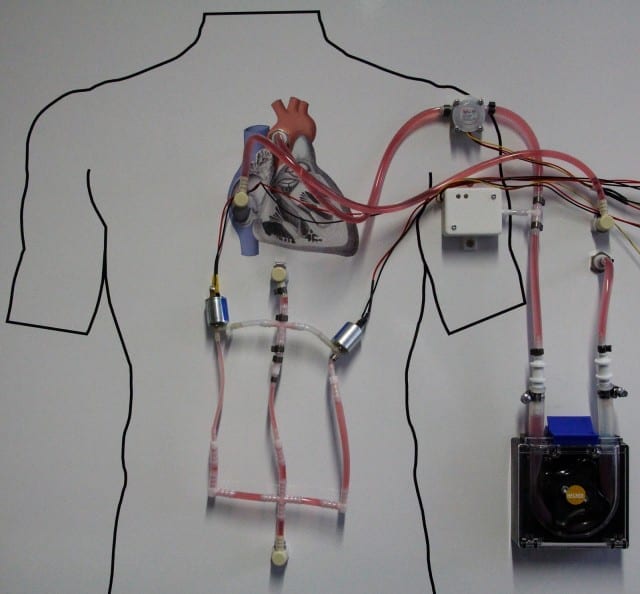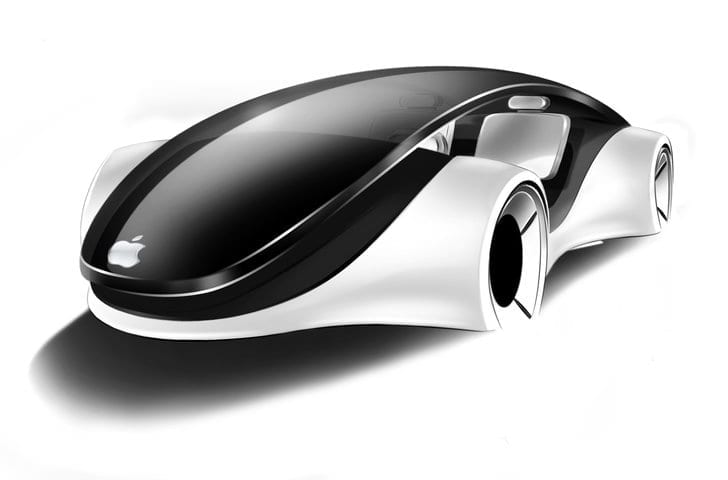
Exhibit to demonstrate the application potential of the hardware-in-the-loop method using the example of a heart assist pump.
Developing medical devices takes a lot of time: large parts of the control systems can be designed and tested only once the hardware is ready. Using the hardware-in-the-loop method, which Fraunhofer researchers have transferred from automotive engineering to medical products, development times and costs can be slashed by up to 50 percent.
Beat by beat, the heart pumps blood through the arteries. In some people, however, the heart is too weak to supply the body with enough oxygen and nutrients, a condition often referred to as myocardial insufficiency or heart failure. A heart pump implanted in the body can help, although the control system that gives the pump the relevant commands must work very precisely.
When developing medical devices such as heart pumps, engineers usually proceed one step after the next (serial development). They first develop the hardware: in this case, the heart pump. Only much later can they complete development of the control software, combine it with the hardware, and test it manually.
Researchers from the Project Group for Automation in Medicine and Biotechnology at the Fraunhofer Institute for Manufacturing Engineering and Automation IPA are speeding up this drawn-out process. “Using the hardware-in-the-loop method, we reduce both development times and development costs by up to 50 percent,” says Jonathan Schächtele, who is a scientist in the project group.
Detecting errors early
Hardware-in-the-loop (HiL) techniques were pioneered in the automotive industry. The previous method had been to develop many components in sequence, whereas HiL allowed engineers to develop parts in parallel processes and shorten integration times. Instead of testing electronic control units (ECUs) on the hardware, which runs the risk of damaging them, engineers create a computer model of the car that includes all details relevant for testing. They use this model to test the ECUs before the vehicle is even built. Special interfaces connect the ECU to the virtual car. The ECU receives information from the vehicle and also sends back commands for the simulated car to execute. Because the process is automated, developers can analyze a large number of test cases while also investigating critical system states in a reproducible, risk-free manner.
Take an engine fault, for instance: does the control system react correctly when the engine dies? Engineers can analyze what happens when, say, a sensor fails, without actually having to snip the connecting wire. In addition, development becomes more transparent from the start, so faults are uncovered at an early stage. Looking at an assembled car and trying to figure out which component a fault is located in is thus a thing of the past.
Increased product safety
Now researchers have transferred this method to modern medical devices in which hardware and software are also strongly intertwined – such as heart pumps. “The challenges they present are similar – medical products are usually complex systems as well,” explains Schächtele. “In addition, scenarios can be tested that could previously be estimated only using manual lab tests – a defect in the system, for instance.” Thanks to HiL, the researchers can speed up the development process and increase the safety of the product. Because the tests run on a fully automated basis, medical device manufacturers can test more situations than previously possible. The automation tends therefore to result in more test runs, and in turn manufacturers can achieve a degree of safety that exceeds the legal requirements. Moreover, documentation of test results, which previously had to be carried out manually, is automatic when using HiL.
The researchers at Fraunhofer IPA offer the whole package. “We design the computer model of the medical product, implement the interfaces between model and control module, define the test cases, and carry out the test runs,” says Schächtele. To help with the automatic test runs and the documentation, the scientists have access to a sort of construction kit.
Learn more: Bringing medical products to market faster
The Latest on: Medical device development
[google_news title=”” keyword=”Medical device development” num_posts=”10″ blurb_length=”0″ show_thumb=”left”]
via Google News
The Latest on: Medical device development
- 908 Devices Inc (MASS) (Q1 2024) Earnings Call Transcript Highlights: Strategic Acquisitions ...on May 1, 2024 at 12:09 am
Discover how 908 Devices leverages strategic acquisitions and innovative products to drive revenue and margin improvements in Q1 2024.
- Bastrop City Council strips some duties from Mayor Lyle Nelson after ethics reprimandon April 30, 2024 at 1:05 pm
The Bastrop City Council limited and stripped some duties from Mayor Lyle Nelson following reprimand by ethics commission.
- Making live music available to all who want to experience iton April 30, 2024 at 4:00 am
While attending a local concert last summer, live music fan Addie Altland, a junior at St. Scholastica Academy in Covington, noticed a lack of attendees with special needs. That observation ...
- iFabric Corp. Receives FDA Medical Device Registration for Apparel Products Utilizing Multiple Textile Technologieson April 30, 2024 at 3:41 am
MARKHAM, ON / ACCESSWIRE / April 30, 2024 / iFabric Corp. ("iFabric" or the "Company") (TSX:IFA.TO)(OTCQX:IFABF), a leading provider of innovative apparel and textile technologies, announces its ...
- Account compromise of “unprecedented scale” uses everyday home deviceson April 29, 2024 at 12:35 pm
Authentication service Okta is warning about the “unprecedented scale” of an ongoing campaign that routes fraudulent login requests through the mobile devices and browsers of everyday users in an ...
- An inside look at Apple's various internal iOS variants that aid developmenton April 29, 2024 at 4:51 am
Along the way to a full release, Apple develops several variants of iOS all with a unique purpose and an entirely different set of users. Here's what they are, when they're used, and by whom.
- 3 Reasons to Buy Advanced Micro Devices Stock Like There's No Tomorrowon April 28, 2024 at 7:03 am
Advanced Micro Devices ( AMD 2.37%) shares returned 441% over the last five years, largely driven by market share gains against Intel in central processing units (CPUs). The company's opportunity ...
- Google Gemini Expands to Android 10 and 11 Deviceson April 28, 2024 at 6:44 am
In what can be described as a shocking announcement, Google has expanded the monotheism of its Gemini bot to devices running Android 10 and Android 11. This is the latest development in the tech ...
- Engineers develop innovative battery technology that could change the future of remote devices: 'An integrated device that could harvest ambient thermal energy'on April 27, 2024 at 3:30 am
With simple increases and decreases in temperature, the new battery can generate enough charge for practical applications in many industries. Engineers develop innovative battery technology that could ...
- FDA spends $1.2M on VR-enabled hub to spur development of at-home care deviceson April 25, 2024 at 10:00 am
The Food & Drug Administration’s device center launched an initiative to promote at-home medical device development with a focus on health equity in at-home care. | Medical devices and other ...
via Bing News










